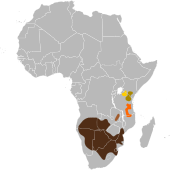Blue wildebeest
| Blue wildebeest | ||||||||||||
|---|---|---|---|---|---|---|---|---|---|---|---|---|

Blue Wildebeest ( Connochaetes taurinus ) |
||||||||||||
| Systematics | ||||||||||||
|
||||||||||||
| Scientific name | ||||||||||||
| Connochaetes taurinus | ||||||||||||
| ( Burchell , 1823) |
The Streifengnu ( Connochaetes taurinus ) is an antelope of the genus wildebeest , as herbivores in open quilting or tree savannah is Africa at home. It is also known as the blue wildebeest .
features
Blue wildebeest have a shoulder height of 140 cm and a high, stocky front body that slopes down to the rear legs. The body weight can reach 270 kilograms. They have a large head with a wide mouth. The coat is brownish or bluish iridescent dark gray. There are dark horizontal stripes from the neck to the rear. A long, black mane covers the neck to the shoulders. A black beard grows on the throat. Both sexes have horns that are reminiscent of cattle horns, but those of the bulls are stronger. The black tail is reminiscent of a ponytail. At birth the calves are light reddish brown and have a darker face.
The sexual dimorphism in blue wildebeest is only slightly pronounced. This characteristic is observed in a number of African antelope species that live in a herd and often undertake long migrations. It is assumed that the small gender difference allows male animals to live in the herd without triggering increased aggressiveness with other male animals in the herd.
distribution
The blue wildebeest lives in large herds in the open grasslands ( savannah ) of southern Africa. It can be found in Zambia , Botswana , Zimbabwe , Angola , Namibia , Malawi , Mozambique, and South Africa .
Systematics
The blue wildebeest originally comprised the subspecies C. t. taurinus , C. t. cooksoni , C. t. johnstoni , C. t. albojubatus and C. t. mearnsi and formed together with the white tailed wildebeest the genus of the wildebeest , which contained only these two species. A revision of the horned bearers in 2011 recognized the subspecies except for C. t. cooksoni as an independent species, which means that the genus of the wildebeest now has five species. Connochaetes taurinus cooksoni was included in the new species Connochaetes johnstoni .
literature
- Richard D. Estes: The Gnu's World: Serengeti Wildebeest Ecology and Life History. University of California Press, Berkeley 2014, ISBN 978-0-520-27319-1 .
- Colin P. Groves and David M. Leslie Jr .: Family Bovidae (Hollow-horned Ruminants). In: Don E. Wilson and Russell A. Mittermeier (eds.): Handbook of the Mammals of the World. Volume 2: Hooved Mammals. Lynx Edicions, Barcelona 2011, ISBN 978-84-96553-77-4 , pp. 707-709.
- Helmut Lingen: Large lexicon of animals . Lingen Verlag, 1989
- Chris & Tilde Stuart: Field Guide to the Larger Mammals of Africa . Struik, 2000, ISBN 1-86872-534-0 .
Web links
- Connochaetes taurinus inthe IUCN 2013 Red List of Threatened Species . Listed by: IUCN SSC Antelope Specialist Group, 2008. Retrieved September 21, 2013.
Single receipts
- ↑ Estes: The Gnu's World . P. 40


